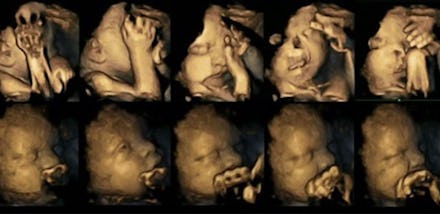Disturbing Images of Fetuses Reveal the Horrific Toll of Smoking While Pregnant

It's no secret that smoking is bad for you. It's bad for your lungs, it's bad for your heart and if you're pregnant, it can be downright lethal for your unborn child.
To learn more about this last point, a new pilot study published in the medical journal Acta Paediatrica looked at fetuses in the wombs of both smokers and nonsmokers and found what appeared to be the unborn children of the smoking mothers literally gasping for breath.
Over the course of dozens of ultrasounds, babies were examined between 24 and 36 weeks of gestation. The study found that babies of the smoking mothers put their hands over their mouth while also seemingly showing an elevated degree of agitation and discomfort.
"Babies need a healthy environment when they're in the womb," David Abramowitz, an Obstetrics and Gynecology Resident at NewYork-Presbyterian/Weill Cornell Medical Center, told Mic. "Anything you do to hinder that is bad."
The facts: Study after study after study has linked smoking while pregnant to adverse health affects in newborn children. According to the U.S. Center for Disease Control, women who smoke during pregnancy increase their chances of a miscarriage.
Babies born to smoking moms are often premature or underweight, sometimes requiring post-birth hospitalization. The chances of developing birth defects like cleft lip and cleft palate also rise for the babies of smokers. When you think about the hundreds of toxic ingredients in cigarettes like cyanide, arsenic and formaldehyde, it's a small miracle that more damage is not done.
Unlike alcohol, which most people can harmlessly stop during pregnancy, cigarettes are highly addictive, thanks to the nicotine cigarette makers artificially add to keep users hooked. Even when the life of your unborn child is at stake, going cold turkey for nine months is asking a lot, and the numbers reflect that.
The CDC found roughly 10% of women smoked during their last trimester, and only 55% of women who smoked before becoming pregnant were able to kick the habit during their pregnancy
Limits of the study. With a sample size of just 20 (16 nonsmokers and four smokers), the Acta study was not large enough to draw any firm conclusions. By its own admission it determined that a larger investigation was needed to confirm the results and to evaluate their meaning.
While scientists and philosophers have debated at exactly what point life begins, it is notoriously difficult to evaluate things like "discomfort" or "agitation" in the unborn. Ultrasound technology has allowed us a window to look inside, but in many ways our technology has outstripped our ability to understand what we're seeing.
In 1984, the documentary The Silent Scream purported to show the horrific and painful death of a 3-month-old fetus during an abortion. Copies were sent to every member of congress and justice of the United States Supreme Court.
The film, however, was widely derided by professionals as being misleading. Many cautioned against overimaginative interpretations of fetal movements. Dr. Jennifer Niebyl, formerly of the John Hopkins School of Medicine, told the New York Times that ''the fetus, at this gestational age, is really exhibiting strictly reflex activity.''
Experts who spoke to Mic were divided over the value of the Acta study. New York Presbyterian's Abramowitz said ultrasound scans are "exactly how we asses the health of the baby," and that ultrasound images in general are "definitely reliable." On the other hand, Ken Altabef, a retired OBGYN who practiced in Garden City, New York, said he had been a child of a woman who smoked, which was a much more common practice in the '60s. "Babies in distress go limp," Altabef said of the study. "It doesn't sound right at all."
Despite the dueling views, the true purpose of the Acta study is more about reminding us what we already know. Smoking kills. No child should have to die at birth, or be born underweight or with birth defects because of secondhand smoke. The Acta trial should be followed up with larger, more comprehensive ones so that the true extent of the damage can be known.
h/t Cosmopolitan
Correction: March 27, 2015: An earlier version of this article implied Dr. Abramowitz was referring to the ultrasound images obtained by the Acta study. The article has been updated to reflect that he was referring to ultrasound images, in general.